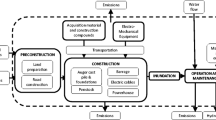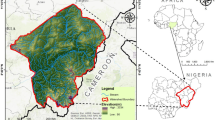Abstract
The choice of site for small hydropower potentials in the inaccessible tracts of Himalayan region is a difficult task by the conventional methods. Present work suggests a site for developing a multipurpose small reservoir under GIS framework, in the Sub Himalayan region, India. Scarcity of geographical, climate and statistical data was the main problem for development of seasonal precipitation and runoff modeling for assessing water potentials and identification of possible small-scale hydropower sites. Small hydropower potential is mainly regulated by head and its durability available at site depending upon capacity of the watershed, underlying the reservoir, to produce the runoff. The study reveals that the Bari-Ka- Khad watershed (BKW) can be considered as a suitable site of interest for small-scale hydropower installation. It is having maximum drainage density (7.45 km/km2) and maximum available relief ratio (0.12), which demonstrates better capacity to produce runoff. According to drainage texture of BKW (Rt = 2.35), it come under coarse texture and higher values of Rho coefficient (ρ = 3.65), suggesting higher hydrologic storage during rainfall and attenuation of effects of erosion during elevated discharge.









Similar content being viewed by others
References
Abrams M (2000) ASTER: data products for the high spatial resolution imager on NASA's Terra platform. Int J Remote Sens 21:847–853
Ahmed SA, Chandrashekarappa KN, Raj SK, Nischitha V, Kavitha G (2010) Evaluation of morphometric parameters derived from ASTER and SRTM DEM–a study on Bandihole sub-watershed basin in Karnataka. J Indian Soc Remote Sens 38:227–238
Baral DJ, Gupta RP (1997) Integration of satellite sensor data with DEM for the study of snow cover distribution and depletion pattern. Int J Remote Sens 18:3889–3894
Bishop MP, Bonk R, Kamp U, Shroder JF (2001) Topographic analysis and modeling for alpine glacier mapping. Polar Geography 25:182–201
Chakrabarti AK (2002) Site evaluation for ranking study of potential hydro-power projects: an Indian perspective using spatial technologies. Proceedings of Map India 2002, 6–8 Feb, New Delhi
Chorley RJ (1969) Introduction to fluvial processes. Methuen and Co Ltd, Bungay
Das S, Paul PK (2006) Selection of site for small Hydel using GIS in the Himalayan Region of India. J Spat Hydrol 6(1)
Desmet PJJ, Govers G (1995) GIS-based simulation of erosion and deposition patterns in an agricultural landscape: a comparison of model results with soil map information. Catena 25:389–401
Dietrich WE, Wilson CJ, Montgomery DR, Mckean J (1993) Analysis of erosion thresholds, channel networks, and landscape morphology using a digital terrain model. J of Geology 101:259–278
Doornkamp JC, Cuchlaine AMK (1971) Numerical analysis in geomorphology-an introduction. Edward Arnold, London
Duncan CC, Klein AJ, Masek JG, Isacks BL (1998) Comparison of late pleistocene and modern glacier extents in central Nepal based on digital elevation data and satellite imagery. Quat Res 49:241–254
Hadley RF, Schumm SA (1961) Sediment sources and drainage basin characteristics in upper Cheyenne River basin. USGS water supply paper, 1531–B, US Geological Survey
Horton RE (1932) Drainage basin characteristics. Trans Am Geophys Union 13:350–361
Horton RE (1945) Erosional development of streams and their drainage catchments. Hydrophysical approach to quantitative morphology. Geol Soc Am Bull 56(3):275–370
Johnstone D, Cross WP (1949) Elements of applied hydrology. Ronald Press, New York
Judson Woods (1990) Economic analysis of energy projects with uncertainty. J of Energy Engineering 116: ASCE
Kirpich ZP (1940) Time of concentration of small agricultural watersheds. Civil Engineering, no.10
Kumar A, et al (2002) Small hydropower assessment-a solution through Hydra-HP software, Proceeding of the conference Map India 2002, 6–8 Feb. New Delhi
Langbein WB (1947) Topographic characteristics of drainage basins.USGS water supply paper, 986 C, US Geological Survey, 125–157
Milkailov (1991) Small & micro- hydro in the USSR, Water power & dam construction, October 1991
Miller VC (1953) A quantitative geomorphic study of drainage basin characteristics in the Clinch Mountain area, Virginia and Tennessee. Proj. NR 389–402, Tech. Rep. 3, Columbia University, Department of Geology, ONR, New York
Mishra AK, Rawat KS (2010) Selection of potential sites for augmenting ground water recharge in manesarnala watershed in gurgaon (haryana) using RS-GIS approch. J Soil Water Conserv 9(4):234–244
Nag SK, Chakraborty S (2003) Influence of rock types and structures in the development of drainage network in hard rock area. J Indian Soc Remote Sens 31:25–35
Narendra K, Nageswara Rao K (2006) Morphometry of the Meghadrigedda watershed, Visakhapatnam district, Andhra Pradesh using GIS and Resourcesat data. J Indian Soc Remote Sens 34:101–110
Nooka Ratnam N, Srivastava YK, Venkateswara Rao V, Amminedu E, Murthy KSR (2005) Check dam positioning by prioritization microwatershedsusing SYI model and morphometric analysis–Remote Sensing and GIS perspective. Photonirvachak 33:25–38
Ozdemir H, Bird D (2009) Evaluation of morphometric parameters of drainage networks derived from topographic maps and DEM in point of floods. Environ Geology 56:1405–1415
Penche C, Minas I (1998) Layman’s Guidebook on how to develop a small hydro site. European Small Reservoir Association (ESHA). Bruselas, Bélgica
Ramos H (2000) Guidelines for design of small Reservoir plants. ed. WREAN (Western Regional Energy Agency & Network) and DED (Department of Economic Development), Belfast, North Ireland
Schumm SA (1956) Evolution of drainage systems and slopes in badlands at Perth Amboy, New Jersey. Geol Soc Am Bull 67:597–646
Sidjak RW, Wheate RD (1999) Glacier mapping of the Illecillewaet icefield, British Columbia, Canada, using Landsat TM and digital elevation data. Int J Remote Sens 20:273–284
Singh S, Dubey A (1994) Geo environmental planning of watersheds in India. Chugh Publications, Allahabad, pp 28–69
Smith KG (1950) Standards for grading textures of erosional topography. Am J Sci 248:655–668
Sreedevi PD (2009) Morphometric analysis of a watershed of South India using SRTM data and GIS. J Geol Soc India 73:543–552
Sreedevi PD, Subrahmanyam K, Ahmed S (2004) The significance of morphometric analysis for obtaining groundwater potential zones in a structurally controlled terrain. Environ Geol 47:412–420
Strahler AN (1952) Dynamic basis for geomorphology. Bull GeolSoc Am 63:923–938
Strahler AN (1957a) Quantitative analysis of watershed geomorphology. Trans Am Geophys Union 38:913–920
Strahler AN (1957b) Quantitative geomorphology of drainage and channel networks. In: Chow YT (ed) Handbook of appliecl hydrology. Me Graw Hill Book Company, New York
Strahler AN (1964) Quantitative geomorphology of drainage basin and channel networks. In: Chow VT (ed) Handbook of applied hydrology. McGraw Hill Book Co., New York, pp 4–76
Temez JR (1978) Cálculohidrometeorológico de caudalesmáximos en pequeñascuencasnaturales. Ministerio de ObrasPúblicas y Urbanismo, DirecciónGeneral de Carreteras
Verstappen HTh (1983) Applied geomorphology-geomorphological surveys for environmental development. Elsevier, New York, pp 57–83
Vijith H, Satheesh R (2006) GIS based morphometric analysis of two major upland sub-watersheds of Meenachilriver in Kerala. J Indian Soc Remote Sens 34:181–185
Vittala SS, Govindaiah S, Gowda HH (2004) Morphometric analysis of the sub-watersheds in the Pavagada area of Tumkur district, South India using remote sensing and GIS techniques. J J Indian Soc Remote Sens 32(4):351–361
Wilford DJ (2004) Recognition of debris flow, debris flood and flood hazard through watershed morphometrics. Landslides 1:61–66
Acknowledgements
Authors are highly grateful to the Project Director (WTC), Joint Director (Research) and the Director of the Indian Agricultural Research Institute, New Delhi for kindly providing the necessary facilities for data analysis during the study.
Author information
Authors and Affiliations
Corresponding author
Rights and permissions
About this article
Cite this article
Rawat, K.S., Mishra, A.K. & Tripathi, V.K. Hydro-morphometrical analyses of sub-himalyan region in relation to small hydro-electric power. Arab J Geosci 6, 2889–2899 (2013). https://doi.org/10.1007/s12517-012-0586-6
Received:
Accepted:
Published:
Issue Date:
DOI: https://doi.org/10.1007/s12517-012-0586-6




